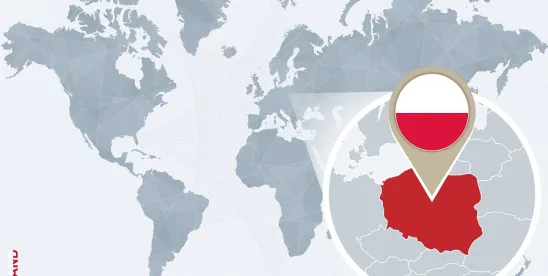WIBOR (Warsaw Interbank Offered Rate) is one of five critical financial benchmarks in the European Union (Commission Implementing Regulation (EU) 2019/482). WIBOR is the interest rate benchmark for the vast majority of złoty-denominated commercial loans, more than 98% of Polish mortgage loans, 26% of the total nominal value of Polish bonds, and € 366 billion in notional amount of OTC interest rate derivatives. It applies to financial instruments with a value greater than Poland’s gross national product.
As a critical benchmark, the methodology for determining WIBOR must be transitioned to comply with the Benchmarks Regulation (BMR – Regulation (EU) 2016/1011 of the European Parliament and of the Council), the same as the most prominent benchmarks subject to this process – EURIBOR®, EONIA® and LIBOR. Poland’s benchmark administrator, GPW Benchmark S.A., recently announced its proposed transition plan for the determination methodology for WIBOR, based on an analysis of the economic, statistical and legal consequences of transition.
Currently, participating banks on the approved panel contribute committed quotes for offer rates for unsecured złoty (PLN) deposits from other participating banks for WIBOR’s specified time periods. The administrator calculates WIBOR as an arithmetic mean of these quotes. According to the most recent report from the National Bank of Poland, the average daily turnover on the interbank unsecured market for deposits was PLN 3.8 billion. However, overnight (O/N) transactions constituted PLN 3.5 billion of this amount, and the remainder were principally tomorrow/next (T/N) and spot/week (S/N). Interbank deposits for the terms that are most significant for the vast majority of financial agreements referencing WIBOR – 3- and 6-month terms – were only sporadic. Although no assertions of manipulation of WIBOR have arisen, the lack of sufficient reference transactions raises concerns as to the transparency of fixing WIBOR for these terms, and emphasizes the need for reform of the methodology.
Poland’s Financial Supervisory Authority is the competent authority for the supervision of WIBOR. In accordance with BMR, it has directed GPW Benchmark to create a methodology that:
-
Reflects more accurately the costs of banks’ wholesale funding;
-
Provides flexibility and adaptability to changing markets, which is especially important in markets where illiquidity occurs, and to avoid manipulation that can occur if the benchmark is not related to the relevant active area of the financial markets; and
-
Results in no disruption to continuity, but follows a gradual and evolutionary approach to ensure financial stability and certainty of business transactions.
The New Proposed “Waterfall” Methodology for Determining WIBOR
In response to the requirements of BMR and the Financial Supervisory Authority, GPW Benchmark recently promulgated its proposed revised methodology for determining WIBOR The methodology follows the “Data Cascade Method” of BMR, commonly referred to as a “Waterfall”.
The basic principle of the revised methodology is to use input data of fixing quotes from Fixing Participants, provided they are available, adequate and sufficient to form a realistic view of the market and of economic realities.
Importantly, O/N and T/N rates will be fixed at 17:00 rather than at 11:00, and will be based on transactions executed that day between 0:00 and 16:30 (15:30 for transactions from Affiliated Markets). Rates for other terms (S/W, 2M, 3M, 6M, 1Y) will continue to be fixed at 11:00, except that 9M WIBOR will no longer be fixed. This change reflects comments that the distinction between overnight rates and other tenors should be manifested.
Also, as part of the Waterfall methodology, transactional data for unsecured złoty deposits from Affiliated Markets – not just other fixing participating banks – will be used. The relevant Affiliated Markets are:
-
Financial Institutions consisting of pension, insurance and investment institutions, mortgage banks, cooperative banks and credit unions; and
-
Remaining Financial Institutions consisting of financial institutions that are not those specified above.
However, unsecured deposits from Public Institutions and Enterprises will not be taken into account.
Participating banks should provide BID and OFFER rates for all terms based on transactional data, if such transactions were executed. Irrespective of the foregoing, participants should provide committed quotes for all terms, including those for which transactional data is provided. This data is then input into an algorithm, which weights the data in accordance with the Waterfall. Thus:
-
Transactional data has the greatest weight;
-
Greater weight is assigned to interbank transactions than to transactions from Affiliated Markets;
-
Transactions for tenors other than the tenors of WIBOR have lesser weight than those for WIBOR tenors;
-
Quotes for transactional data have higher weight than quotes for interpolated data;
-
Transactional data from Financial Institutions have greater weight than transactional data from Remaining Financial Institutions.
Fixing Participants apply the algorithm to the input data, taking into account the hierarchical principles. Details of application of the algorithm are available in the methodology paper published by GPW Benchmark, available here (in Polish).
Effect of the Proposed Methodology
A principal goal of the proposal is to not introduce a new benchmark – the illiquidity that exists in segments of the interbank market would mean further confusion if more than one benchmark existed.
A second principal goal is to maintain the essential elements of the methodology for determining WIBOR, with no change of the benchmark name, in order to not require amendment of existing financial agreements. Thus, the proposed methodology maintains the same definition of the base market. Irrespective of this, we believe that financial agreements will still need to be reviewed to ascertain whether current WIBOR definitions in such agreements comply with the new methodology. For instance, until 30 June 2017 the benchmark administrator was ACI Polska – the Polish Financial Markets Association, not GPW Benchmark – and definitions of WIBOR referring to the prior administrator should be updated.
The methodology paper published by the benchmark administrator contains simulations which GPW Benchmark asserts support the conclusion that the proposed methodology will not constitute a material change to WIBOR, thus avoiding market disruptions.
The original deadline for implementing the transformation of benchmarks throughout Europe was 1 January 2020, but this has been extended by the European Commission to 1 January 2022. Notwithstanding this extension, Poland’s Financial Supervisory Authority has repeatedly publicly announced that due to the risks to the financial system of an uncertain transition of WIBOR and resulting financial market disruption, it expected GPW Benchmark as the financial administrator to avoid surprising the markets and by the end of 2019 to submit its applications for the transition of WIBOR and approval of its role as benchmark administrator.
GPW Benchmark has asked market participants to comment on its proposed methodology by September. It has also pledged to comply with the Authority’s request and to file its applications in December 2019. It is expected that review by the Financial Supervisory Authority will take several months. The Authority is required to review the proposed WIBOR determination methodology for its integrity and robustness in accordance with BMR, and to ensure that GPW Benchmark has in place sufficient organizational systems, along with oversight, accountability, auditing and record-keeping controls. If the December deadline is met, there should be sufficient time for Poland’s financial markets to prepare for the proposed changes.





 />i
/>i

